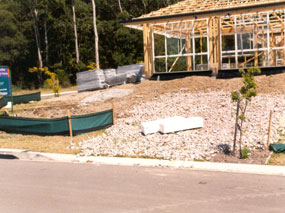IECA Australasia
HISTORY OF THE ASSOCIATION
What we now know as the IECA began when a Washington State hydroseeding and tree service contractor, Mr George Harrison, polled a group of contractors in 1971 to find out if any interest existed for creating an erosion control contractor’s group. The result was the first erosion control conference, held on 15 January 1972 in Portland, Oregon. Thirty-five people from four states attended, including representatives from seven product and equipment suppliers.
This event was a historic one, for it established from the outset one of the IECA’s greatest strengths – bringing people together to solve problems. This first meeting addressed the pitfalls of the erosion control contracting business, which then was very much a young and raw business. The conference concluded with a discussion of creating an association of erosion control specialists.
Organizing committees were quickly formed and, on 20 November 1972, today’s leading erosion control association was born, initially as the National Erosion Control Association. The first Board of Directors, under the leadership of George Harrison, quickly added more vision to the Association by aspiring to include professionals from all over the world.
On 18 February 1973, the Association’s name was officially changed to the International Erosion Control Association. The original filing documents included goals that the IECA still follows today: the collection and dissemination of information; encouragement of research; promotion of professional skills and education; and the development of industry standards. The leaders of the early years of Association led with vision, despite a relatively small membership and an even smaller budget.
Throughout the early 1980s, the IECA’s activities focussed primarily on its annual conference. However, by 1987 the Association had adopted its first long range strategic plan and discussions began on the development of national and international chapters. In 1988, US state representatives were selected to initiate Chapter development.
The year 1989 was a landmark year for the IECA on several fronts. Internationally, the Association held two meetings. The annual conference and trade exposition was held in Vancouver, British Columbia, Canada and, in an effort to develop a European Chapter, a symposium on soil erosion control was held in London, England. Two other historic events occurred this year including the formation of the Association’s Committee on Standards and the publication of the first Products and Services Directory.
In the 1990’s, the IECA emerged as the leading association for erosion and sediment control professionals. Notable achievements included the creation of the Association’s Scholarship Program, which to date has brought 60 students representing 20 different countries to the US annual conference. No doubt this program has jump-started many young careers with exposure to the world’s leading authorities and technology. Sponsor programs have been created to support scholarships and the annual conference financially.
In 1994, Australasia was the first Chapter outside the USA to be chartered. Since then, conferences have been held in Australia, Spain and the Philippines. By the late 1990s, chapters were flourishing due to the dedicated efforts of regional volunteers. Chartered or provisional chapters have now been established on five continents.
In the next year, the IECA became a cosponsor of the Certified Professional in Erosion and Sediment Control program and helped promote the value of certification to its members and the industry. Specialised training was developed for erosion control professionals seeking new skills and knowledge. With the initial offering of the 1-day course Fundamentals of Erosion and Sediment Control, the Association’s Professional Development Training Program was launched. Today, the program has trained more than 4,000 people and includes a variety of introductory and advanced courses, including preparatory courses for certification applicants.
More recently, the IECA created the annual Awards of Environmental Excellence to honour outstanding achievements in the field of natural resource conservation and environmental protection. More than 50 projects, individuals and organizations have been recognized from 13 countries for their contributions to the advancement of the erosion and sediment control profession.
What does the future hold for IECA? A look ahead reveals exciting possibilities for the Association and its members? Some of these include:
Improved member management databases and web sites will enable the Association to link members to each other to solve specific problems. Technology sections will be created to provide topic-specific information and benefits.
Regional meetings will become more common including regular conferences on all major continents. Specialized conferences will be held that focus on issue oriented topics, including erosion control economics, performance standards, new regulations, design technology and more.
A greater range of professional development courses will be available, driven by member and industry needs. Training will occur internationally and offer multilingual education. A greater emphasis will also be placed on developing college level curricula, field schools and research centres.
Performance standards will become a reality providing greater consistency and utility of erosion control technology for design professionals, manufacturers, regulators and contractors.
A foundation for member directed research and scholarships will shape future leaders and technology. A market reporting system will enable Association to profile the industry better and provide valuable information for business leaders.
These are just a few of the exciting developments awaiting IECA members as we enter the 21st century. The Association engenders a sense of belonging to its members. In turn, members are empowered to participate in a dynamic and exciting profession, and to help guide us into the future. New frontiers of learning and problem solving await those who grasp the opportunities. The Association will continue to be the leading association for erosion and sediment control professionals around the world. Don’t miss the journey!


.jpg)